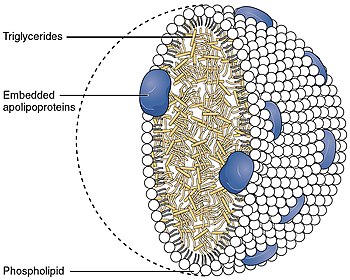User:Andrew Su/Sandbox/APOE
An Error has occurred retrieving Wikidata item for infobox
Summary[edit]
Chylomicron remnants and very low density lipoprotein (VLDL) remnants are rapidly removed from the circulation by receptor-mediated endocytosis in the liver. Apolipoprotein E, a main apoprotein of the chylomicron, binds to a specific receptor on liver cells and peripheral cells. ApoE is essential for the normal catabolism of triglyceride-rich lipoprotein constituents. The APOE gene is mapped to chromosome 19 in a cluster with APOC1 and APOC2. Defects in apolipoprotein E result in familial dysbetalipoproteinemia, or type III hyperlipoproteinemia (HLP III), in which increased plasma cholesterol and triglycerides are the consequence of impaired clearance of chylomicron and VLDL remnants.
Apolipoprotein E (APOE), a main apoprotein of the chylomicron, binds to a specific receptor on liver cells and peripheral cells.
Function[edit]
APOE[1] is essential for the normal catabolism of triglyceride-rich lipoprotein constituents. APOE was initially recognized for its importance in lipoprotein metabolism and cardiovascular disease. More recently, it has been studied for its role in several biological processes not directly related to lipoprotein transport, including Alzheimer's disease (AD), immunoregulation, and cognition. Neonates with brain injuries and/or defects who also have abnormalities in the APOE gene may have an increased risk for cerebral palsy, according to researchers at the Northwestern University Feinberg School of Medicine. Defects in APOE result in familial dysbetalipoproteinemia, or type III hyperlipoproteinemia (HLP III), in which increased plasma cholesterol and triglycerides are the consequence of impaired clearance of chylomicron, VLDL and LDL remnants.
APOE is 299 amino acids long and transports lipoproteins, fat-soluble vitamins, and cholesterol into the lymph system and then into the blood. It is synthesized principally in the liver, but has also been found in other tissues such as the brain, kidneys, and spleen. In the nervous system, non-neuronal cell types, most notably astroglia and microglia, are the primary producers of APOE, while neurons preferentially express the receptors for APOE. There are seven currently identified mammalian receptors for APOE which belong to the evolutionarily conserved low density lipoprotein receptor gene family.
Gene[edit]
The APOE gene, ApoE, is mapped to chromosome 19 in a cluster with Apolipoprotein C1 and Apolipoprotein C2. ApoE consists of four exons and three introns, totaling 3597 base pairs.
The gene is polymorphic, with three major alleles, ApoE2, ApoE3, ApoE4, which translate into three isoforms of the protein: normal - ApoE-ε3; dysfunctional - ApoE-ε2 and ApoE-ε4. These isoforms differ from each other only by single amino acid substitutions at positions 112 and 158, but have profound physiological consequences.
- E2 is associated with the genetic disorder type III hyperlipoproteinemia and with both increased and decreased risk for atherosclerosis.
- E4 has been implicated in atherosclerosis and AD, impaired cognitive function, and reduced neurite outgrowth.
ApoE is a target gene of liver X receptor, a nuclear receptor member that play role in metabolism regulation of cholesterol, fatty acid, and glucose homeostasis.
Alzheimer's Disease (AD)[edit]
APOE-ε4 has been shown to cause an increased susceptibility to Alzheimer's disease.[2] The pivotal role of ApoE in AD was first identified through linkage analysis by Margaret Pericak-Vance while working in the Roses lab at Duke University. Linkage studies were followed by association analysis confirming the role of the APOE-ε4 allele.
Although 40-65% of AD patients have at least one copy of the 4 allele ApoE4 is not a determinant of the disease - at least a third of patients with AD are ApoE4 negative and some ApoE4 homozygotes never develop the disease.
Among ApoE4 carriers, another gene, GAB2, is thought to further influence the risk of getting AD.[3]
There is also evidence that the 2 allele may serve a protective role in AD.[4]
Thus, the genotype most at risk for Alzheimer's disease and at earlier age is ApoE 4,4. The ApoE 3,4 genotype is at increased risk, though not to the degree that those homozygous for ApoE 4 are. The genotype ApoE 3,3 is considered at normal risk for Alzheimer's disease. The genotype ApoE 2,3 is considered at less risk for Alzheimer's disease. Interestingly, people with both a copy of the 2 allele and the 4 allele, ApoE 2,4, are at normal risk similar to the ApoE 3,3 genotype.
References[edit]
- ^ Singh PP, Singh M, Mastana SS (2002). "Genetic variation of apolipoproteins in North Indians". Hum. Biol. 74 (5): 673–82. PMID 12495081.
{{cite journal}}: CS1 maint: multiple names: authors list (link) - ^ Corder EH, Saunders AM, Strittmatter WJ, Schmechel DE, Gaskell PC, Small GW, Roses AD, Haines JL, Pericak-Vance MA (1993). "Gene dose of apolipoprotein E type 4 allele and the risk of Alzheimer's disease in late onset families". Science. 261 (5123): 921–3. PMID 8346443.
{{cite journal}}: CS1 maint: multiple names: authors list (link) - ^ Reiman EM, Webster JA, Myers AJ, Hardy J, Dunckley T, Zismann VL, Joshipura KD, Pearson JV, Hu-Lince D, Huentelman MJ, Craig DW, Coon KD, Liang WS, Herbert RH, Beach T, Rohrer KC, Zhao AS, Leung D, Bryden L, Marlowe L, Kaleem M, Mastroeni D, Grover A, Heward CB, Ravid R, Rogers J, Hutton ML, Melquist S, Petersen RC, Alexander GE, Caselli RJ, Kukull W, Papassotiropoulos A, Stephan DA (2007). "GAB2 Alleles Modify Alzheimer's Risk in APOE varepsilon4 Carriers". 54 (5): 713–720. doi:10.1016/j.neuron.2007.05.022. PMID 17553421.
{{cite journal}}: Cite journal requires|journal=(help)CS1 maint: multiple names: authors list (link) Free full text Free PDF Genetic data in the public domain - ^ Corder EH, Saunders AM, Risch NJ, Strittmatter WJ, Schmechel DE, Gaskell PC, Rimmler JB, Locke PA, Conneally PM, Schmader KE (1994). "Protective effect of apolipoprotein E type 2 allele for late onset Alzheimer disease". Nat. Genet. 7 (2): 180–4. doi:10.1038/ng0694-180. PMID 7920638.
{{cite journal}}: CS1 maint: multiple names: authors list (link)
External links[edit]
- Apolipoproteins+E at the U.S. National Library of Medicine Medical Subject Headings (MeSH)

